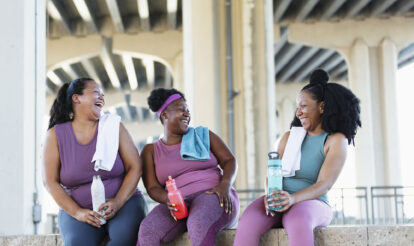
Winter challenges to women’s health (and what to do about them)
Winter challenges to women’s health (and what to do about them)

The cold, dark winter season can be difficult for everyone, but it may also bring unique challenges to women’s health. From mood disruptions and hormonal imbalances to skin concerns, winter may have a significant impact on both physical and mental well-being.
For women, maintaining health and vitality during winter can be as simple as adding a few extra nutrients to the daily regime. Here’s an overview of what you might face, and how to tackle it.
Seasonal Affective Disorder (SAD)
Women are four times more likely than men to be affected by seasonal affective disorder, a form of depression associated with the shorter, darker days of winter.[1] SAD can contribute to low mood and lack of energy, lethargy, difficulty concentrating, increased cravings for carbohydrates and sugars, and sleeping more than usual.[2]
Women most at risk of SAD are aged around 18-30 years, live far from the equator, and also have family histories of mood disorders.[3]
Suggestion: Light therapy and/or sunshine
Bright Light Therapy (BLT) is already a first-line treatment for SAD and may also be helpful for women who struggle with mood and/or PMS symptoms in winter. Research suggests that SAD is linked to disruptions in circadian rhythm and serotonin reuptake, and light exposure is an effective means of restoring endogenous circadian rhythms.[4] BLT may also help to increase available serotonin in the brain, supporting healthy mood.[5]
Bright light therapy generally involves sitting in front of a light box for a set amount of time each day, usually within half an hour of waking up. Spending time outside in the sunlight (when possible) can also be helpful.
Premenstrual issues
Women who struggle with either premenstrual syndrome (PMS) or premenstrual dysphoric disorder (PMDD) are more likely to be affected by SAD.[6] PMDD is a severe form of PMS that can contribute to heightened emotional and physical symptoms.
One study found that around 46% of women with SAD also met the criteria for PMDD, reporting significant seasonal mood changes and symptoms such as low energy and difficulty sleeping. Of these, 25% reported that their premenstrual symptoms were worse during winter.[7]
Low vitamin D – which is common during winter – may also contribute to heightened PMS symptoms. Estradiol increases during the luteal phase of the menstrual cycle, activating the breakdown of vitamin D. Low vitamin D can lead to increased fluid retention and blood pressure, which may worsen bloating and discomfort.[8]
Suggestion: Exercise + Vitamin D
Managing PMS symptoms often requires both physical and nutritional interventions. Aerobic exercise such as walking and running is found to be one of the most effective ways to alleviate PMS symptoms and improve overall well-being.[9]
Maintaining adequate vitamin D levels is also important. Taking vitamin D in supplement form has been found to improve symptoms and reduce pain intensity in women who struggle with PMS symptoms.[10]
Menstrual discomfort
Dysmenorrhea (moderate to severe pain during menstruation) can intensify in the colder months. Temperatures below 20°C trigger a protective response in the body, leading to reduced blood flow and increased production of prostaglandins – substances that can increase sensitivity to pain.[11]
Some research suggests that prolonged exposure to colder temperatures can also lead to greater release of endothelin, a protein that induces the tightening of blood vessels in the uterus. This may also increase pain during menstruation.[11]
Suggestion: Magnesium
Magnesium is often recommended for period pain as it assists with both muscle relaxation and vasodilation, and may also help reduce the synthesis of prostaglandins.[12] Magnesium may also help to calm the nervous system and regulate the actions of ovarian hormones, particularly progesterone.[13]
Combining magnesium with vitamin B6 is shown to be particularly effective in managing PMS symptoms, possibly due to the hormone-balancing effects of B6.[14][15]
Dry skin, hair, and nails
Women may also find that winter temperatures affect their hair, skin, and nails. Cold winter air holds less moisture than warm air, which can result in moisture being drawn from the body, potentially leading to dry, flaky skin and weak nails.[16] Indoor heating can increase the loss of moisture from the skin while also increasing air pollution. The combination of these factors may affect the skin’s regenerative processes and worsen certain skin conditions, even after short‐term exposure to an indoor environment in winter.[17]
Suggestion: Purified fish oil
Linoleic acid, a dominant omega-6 fatty acid in fish oil, is also the richest fatty acid in the skin and a precursor to ceramide, which makes up most of the skin’s permeability barrier. Numerous studies have shown that fish oil supplementation can be an effective treatment for dry skin conditions by helping to restore moisture within the cell membrane.[18]
Supporting your health throughout winter and beyond often requires a tailored approach that includes adjustments to your diet, physical activity, and the addition of necessary nutrients. If your health challenges persist, consult a qualified health professional for further guidance. Support your overall health and wellbeing with our unique set of nutraceuticals products.
This content is for educational purposes only and is not a substitute for health professional advice.
[1] Rosenthal NE. Seasonal affective disorder. Norman E. Rosenthal, MD. Published July 14, 2023. Accessed February 4, 2025. Available at: https://www.normanrosenthal.com/about/research/seasonal-affective-disorder/
[2] Ganzer CZ. Seasonal affective disorder: an overview. Ment Health Pract. Accessed February 4, 2025. Available at: https://journals.rcni.com/mental-health-practice/seasonal-affective-disorder-an-overview-mhp.18.9.21.e973
[3] Rosen LN, Targum SD, Terman M, et al. Prevalence of seasonal affective disorder at four latitudes. Psychiatry Res. 1990;31(2):131-144. doi:10.1016/0165-1781(90)90116-m
[4] Roenneberg T, Foster RG. Twilight times: light and the circadian system. Photochem Photobiol. 1997;66(5):549-561. doi:10.1111/j.1751-1097.1997.tb03188.x
[5] Campbell PD, Miller AM, Woesner ME. Bright light therapy: seasonal affective disorder and beyond. Einstein J Biol Med. 2017;32:E13-E25.
[6] Pereira D, Pessoa AR, Madeira N, Macedo A, Pereira AT. Association between premenstrual dysphoric disorder and perinatal depression: a systematic review. Arch Womens Ment Health. 2022;25(1):61-70. doi:10.1007/s00737-021-01177-6
[7] Praschak-Rieder N, Willeit M, Neumeister A, et al. Prevalence of premenstrual dysphoric disorder in female patients with seasonal affective disorder. J Affect Disord. 2001;63(1-3):239-242. doi:10.1016/s0165-0327(00)00176-2
[8] Abdi F, Ozgoli G, Rahnemaie FS. A systematic review of the role of vitamin D and calcium in premenstrual syndrome. Obstet Gynecol Sci. 2019;62(2):73-86. doi:10.5468/ogs.2019.62.2.73
[9] Liguori F, Saraiello E, Calella P. Premenstrual syndrome and premenstrual dysphoric disorder’s impact on quality of life, and the role of physical activity. Medicina (Kaunas). 2023;59(11):2044. doi:10.3390/medicina59112044
[10] Amzajerdi A, Keshavarz M, Ghorbali E, et al. The effect of vitamin D on the severity of dysmenorrhea and menstrual blood loss: a randomized clinical trial. BMC Womens Health. 2023;23:138. doi:10.1186/s12905-023-02284-5
[11] Wang D, Cheng X, Fang H, et al. Effect of cold stress on ovarian and uterine microcirculation in rats and the role of endothelin system. Reprod Biol Endocrinol. 2020;18(1):29. doi:10.1186/s12958-020-00584-1
[12] Proctor ML, Murphy PA. Herbal and dietary therapies for primary and secondary dysmenorrhea. Cochrane Database Syst Rev. 2001;(3):CD002124. doi:10.1002/14651858.CD002124
[13] Quaranta S, Buscaglia MA, Meroni MG, Colombo E, Cella S. Pilot study of the efficacy and safety of a modified-release magnesium 250 mg tablet (Sincromag) for the treatment of premenstrual syndrome. Clin Drug Investig. 2007;27(1):51-58. doi:10.2165/00044011-200727010-00004
[14] Fathizadeh N, Ebrahimi E, Valiani M, Tavakoli N, Yar MH. Evaluating the effect of magnesium and magnesium plus vitamin B6 supplement on the severity of premenstrual syndrome. Iran J Nurs Midwifery Res. 2010;15(Suppl 1):401-405.
[15] Abraham GE. Nutritional factors in the etiology of the premenstrual tension syndromes. J Reprod Med. 1983;28(7):446-464.
[16] Pastar I, Stojadinovic O, Yin NC, et al. Epithelialization in wound healing: a comprehensive review. Adv Wound Care (New Rochelle). 2014;3(7):445-464. doi:10.1089/wound.2013.0473
[17] Park EH, Jo DJ, Jeon HW, Na SJ. Effects of winter indoor environment on the skin: unveiling skin condition changes in Korea. Skin Res Technol. 2023;29(6):e13397. doi:10.1111/srt.13397
[18] Huang TH, Wang PW, Yang SC, Chou WL, Fang JY. Cosmetic and therapeutic applications of fish oil’s fatty acids on the skin. Mar Drugs. 2018;16(8):256. doi:10.3390/md16080256




